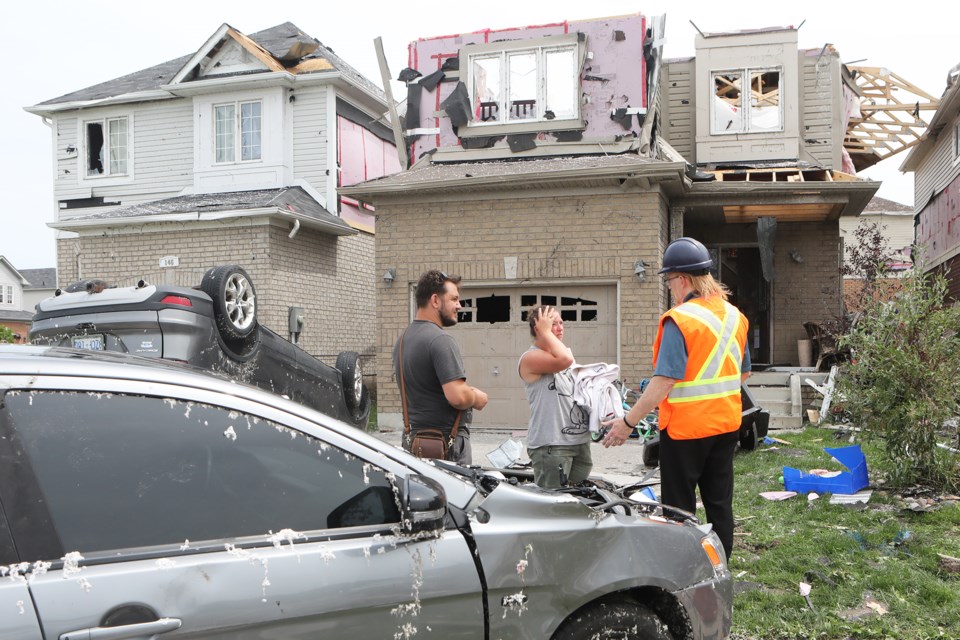Up to 40 homes damaged by Thursday’s tornado may be condemned after many of them lost their roofs, some due to poor workmanship, an engineering professor with Western University’s The Northern Tornadoes Project believes.
“With some of the roofs off, the whole roof off, we saw a lack of following the building code," said Greg Kopp, ImpactWX chair in severe storms engineering and the project’s lead researcher.
"There weren’t sufficient nails, in many cases there were no nails holding the roof onto the walls. And during a tornado, or any wind storm, the roof becomes like a wing and wants to lift up, so you have to hold it down," said Kopp.
“In many cases we found a lack of following the building code on that. Some of these roofs could have stayed on, I think, if they were built to code.”
City inspectors have deemed 60 homes to be currently uninhabitable.
Any shortcuts in construction will undoubtedly be addressed as examination of the scene and the houses continues, said Barrie Mayor Jeff Lehman, who called the news of the workmanship distressing.
While construction of homes have improved over time, particularly compared to the structures that were destroyed in the 1985 tornado that resulted in deaths, there are still inconsistencies.
“These homes I’m standing here looking at them, largely brick construction or brick ground floor … you can see even here the ones that were frame homes have taken more damage,” said Lehman while examining the devastation Friday. “I think one of the hard outcomes of this will be making sure that those storm nails and those things that have to be part of construction will have to be followed.”
City officials have issued and posted unsafe orders on homes that have sustained extensive structural damage and deemed to be unsafe. Those orders are intended to keep people out of the damaged buildings until they can be assessed and temporarily repaired.
The Northern Tornadoes Project researchers arrived in Barrie before dark Thursday to begin their examination at the scene. Their goal is to arrive as quickly as they can to find and examine the trusses and whole roofs on the ground where they landed along with the nails and bolts that are critical during the construction.
Roofs for wood-framed houses are considered light and must be nailed down to avoid loss and damage, Kopp explained before conducting final examinations of the scene Friday.
A few hundred extra dollars during construction could ensure their stability, he said. Experts have now for years discussed the value of hurricane straps which add a level of security to structures.
“You can build a house that will stay together in a tornado of about this strength (EF2). And so if this community had been built to be tornado resilient, it would add a few hundred dollars to a house, but all the roofs would have been on.”
The Northern Tornadoes Project is working with a builder in St. Thomas who is building a whole community with advice from the tornado experts which includes using longer nails on the roof sheeting and extra strapping.
Those measures won’t prevent damage like the loss of siding and shingles and broken windows and doors, said Kopp, but the roof would be secure and the residents would eventually be back in their homes.
“What I’m really afraid of for these people here, I don’t think they realize, but some of them are going to be out of their house for a couple of years,” he said. “And with young kids, schooling disruption and after this past year with schooling disruption, their lives are going to take a while to get back to normal.
“And that’s the tragedy of it to me.”
With an estimate of 10 to 20 houses now with no roof or displaced roofs, up to 40 houses in that tornado-stricken area could be declared condemned, meaning they can’t be repaired and will have to be rebuilt, based on the experience the project’s team has gained at other events.
Some houses, Kopp added, have clearly lost their roofs and while other homes appear sound, they may have had the roofs shift and are considered unsafe because they’re not connected to the walls.
That, said Kopp, will be determined by inspectors who go into the homes for closer examination.
Part of the role of the Northern Tornado Project is to determine the strength of the winds by assessing the damage in the absence of live wind speed measurement.
By examining the displaced roofs and collapsed walls, based on their knowledge of the strength of houses and aerodynamics and the Enhanced Fujita (EF) scale, they were able to estimate that the tornado travelled through the area at 210 kilometres per hour, identifying the tornado as an EF2.
The aim of the project is to capture data for every tornado in Canada, mapping the details, including tornadoes in forests. They’ve found in situations such as Thursday’s storm, multiple tornadoes are often where the strongest tornadoes are.
“We want that information because that helps us with risk modelling, things that get designed for tornadoes,” said Kopp. “The electrical grid, for example, is like a big tornado net across the continent, so you want to know risk about that.
“We think you could mitigate damage to houses as well. So having a better understanding of the risk and occurrence rate is very important. And of course warning, so we always want to provide a ground truth for Environment Canada too on actually what happened so they can improve their warning systems.”



